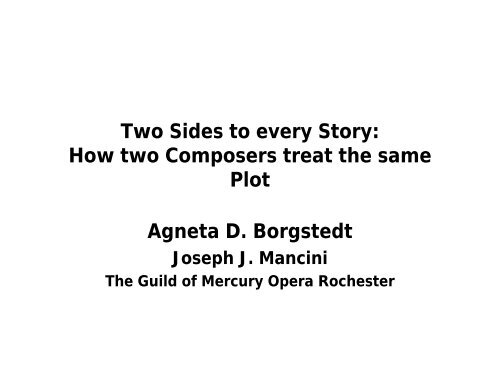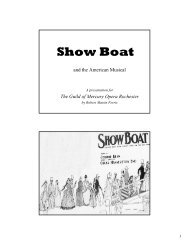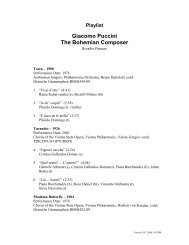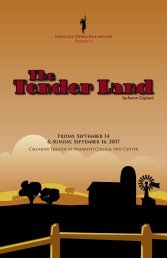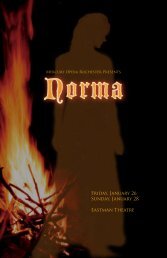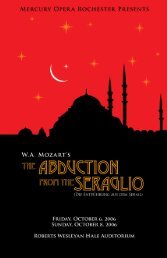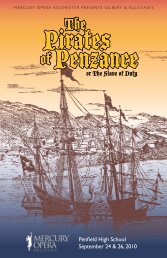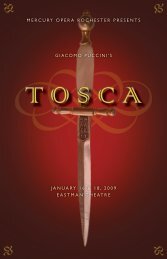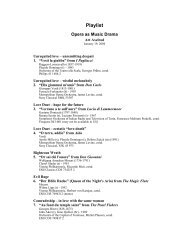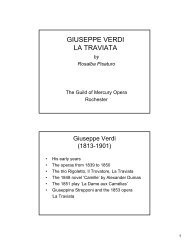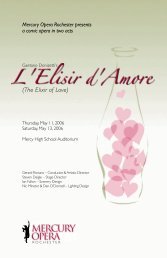Handout - Opera Guild of Rochester
Handout - Opera Guild of Rochester
Handout - Opera Guild of Rochester
You also want an ePaper? Increase the reach of your titles
YUMPU automatically turns print PDFs into web optimized ePapers that Google loves.
The <strong>Guild</strong> <strong>of</strong> Mercury <strong>Opera</strong> <strong>Rochester</strong><strong>Guild</strong> addressP.O. Box 92245<strong>Rochester</strong> NY 14692Mercury <strong>Opera</strong> <strong>Rochester</strong> Websitewww.mercuryoperarochester.org with link to <strong>Guild</strong><strong>Guild</strong> contactsDr. Agneta D. Borgstedt, President 585 334 2323Agneta.Borgstedt@earthlink.netHelga Strasser, Trip coordinator 585 586 2274Helgas@rochester.rr.comArthur Axelrod, Vice-President,<strong>Guild</strong>lectures and technical assistance 585377 6133Artax@rochester.rr.com
Two Composers, one <strong>Opera</strong> Theme• In opera history it is not unusual that more thanone composer has used the same opera themeand even the same libretto.• From the beginning <strong>of</strong> the first opera l’Orfeo lbyMonteverdi in 1607 to Gluck’s s Orfeo ed Euridice1762 to Offenbach’s s Orphee aux enfers 1858,composers set music to the same stories.• The Metastasio libretto for La Clemenza di Titowas set to music 40 times before Mozart used itfor his opera to celebrate the coronation <strong>of</strong>Leopold II in 1791.
Two Composers, one <strong>Opera</strong> Theme• In this lecture we will compare 5 opera stories setto music by two composers during the 19 thCentury.• We will compare the operatic styles <strong>of</strong> thebeginning to the last part <strong>of</strong> the 19 th century.• I will present to you similar events in each operato illustrate the differences in the use <strong>of</strong>orchestration and emphasis on the characters.• Some <strong>of</strong> the lesser known operas are onlyavailable as a recording and not in DVD. You willsee the translations on the screen for the Audio.
Two Sides to every Story:How two Composers treat the samePlotOtello: Willow songGiachino Rossini 1816 Giuseppe Verdi 1887Romeo and Juliette: Tomb scene with RomeoVincenzo Bellini 1830 Charles Gounod 1867Mermaid (Undine) <strong>Opera</strong>s: Mermaid Love SongsAlbert Lortzing 1845 Antonin Dvorak 1901
Two Sides to every Story:How two Composers treat the samePlotFalstaff, after being thrown into the ThamesOtto Nicolai 1849 Giuseppe Verdi 1893La Boheme: Musetta’s s WaltzRuggiero Leoncavallo 1897 Giacomo Puccini 1896
Otello• Rossini’s s opera from his Naples period is romanticwith light orchestration and a lot <strong>of</strong> coloraturaembellishment <strong>of</strong> the arias.• Verdi has heavier orchestration with dramaticpresentation <strong>of</strong> many arias to emphasize thecharacters.• The story in Rossini’s s Otello follows closer to theShakespeare play and starts in Venice. Verdi’sopera starts in Cypress where Otello is sent by theDoge <strong>of</strong> Venice to fight the Turks.
Otello• Rossini’s s opera has three tenors: Otello, Jago andRodrigo. In Verdi’s s opera Otello is a dramatictenor and Jago a dramatic baritone.• The willow song is sung by Desdemona in the lastact before she retires to bed with ominousforebodings for the events to come.• You will hear in succession the Rossini audiorecording with Patricia Ci<strong>of</strong>i: CD3, Act III,Tract 3• Verdi DVD with Renee Fleming Act V, Chapter 41and 42.
Rossini’s s Willow SongDesdemonaSeated at the foot <strong>of</strong> a willow, plunged in grief,Isaura moaned, wounded by most cruel love:A s<strong>of</strong>t breeze repeated her voice among thebranches.The crystal brooks united the murmur <strong>of</strong> theirdifferent paths to her sigh <strong>of</strong> love:A s<strong>of</strong>t breeze repeated her voice among thebranches.Willow, delight <strong>of</strong> love!
Rossini Willow Song continuedCast a merciful shade, heedless <strong>of</strong> my misfortunes,onto my fatal grave;And never may the breeze repeat the sound <strong>of</strong> mylamentsWhat have I said!..Ah, I was mistaken!..This is not the gloomy end <strong>of</strong> my song. Hear me..(A gust <strong>of</strong> wind shatters some panes <strong>of</strong> the window)Oh God!What is this noise! What an ill omen!
Rossini Willow song continuedEmiliaFear not; look: it is a raging wind blowing.DesdemonaI thought that somebody..Oh, how the Heavens join in my laments!Hear the end <strong>of</strong> my mournful story.“But weary at last <strong>of</strong> pouring sorrowful sighs and tears, theafflicted virgin died, ah besides the willow.But weary at last <strong>of</strong> weeping she died…how sad! Theungrateful man, alas… but tears do not let me continue.”Go, receive your friends last kiss.
Rossini Willow song endEmiliaO, what are you saying!I obey… oh, how I tremble!
Romeo and Juliette• The Bellini version <strong>of</strong> E Capuleti E I Montecchi, the Capuletsand the Montagues, is based on the sources whichShakespeare used for his play.• The Gounod version is based closely on the Shakespeareplay.• Some <strong>of</strong> the characters have different positions in the twooperas. In the Bellini version it is Tebaldo who is elected byJuliette’s s father to be her husband, in the Gounod opera it isParis.• In Bellini’s s opera Romeo is sung by a mezzo-soprano in atrouser role, in Gounod’s s opera Romeo is a lyric tenor.
Romeo and Juliette• In Gounod’s s opera the emphasis is on therelationship <strong>of</strong> Romeo and Juliette where in theBellini opera the strife between the warringfractions is also a prominent part <strong>of</strong> the story.• Lorenzo is a doctor who gives Juliette thesleeping potion in Bellini’s s opera and is a priest inGounod’s s opera.• The Queen Mab ballad is only in the Gounodopera.
Romeo in the Tomb Scene• You will see in succession DVDs <strong>of</strong> both operas• The Bellini opera is from a 2006 production <strong>of</strong> theFestival della valle d’Itria ddi Martina Franca inmodern dress (typical <strong>of</strong> some European Regiedriven operas) sung by mezzo-soprano ClaraPolito. Act II, Chapter 10, stop when he lies down• In Gounod’s s opera we have an opulent traditionalproduction from the Royal <strong>Opera</strong> Covent Gardenwith lyric Tenor Roberto Alagna from 1994Act V, Chapter 24, stop after he drinks the poison.
Mermaid (Undine) <strong>Opera</strong>s, Mermaid LoveSongs• Mermaids (Undine) are water creatures that looklike humans but do not have a soul. They canobtain it if a human loves them and marries them.• First mention <strong>of</strong> mermaids is documented in the16 th century by Paracelsus.• The novel by Friedrich de la Motte-Fouque 1811influenced 16 Mermaid operas starting with E.T.H.H<strong>of</strong>fmann’s s Undine 1816 to Dvorak’s s Rusalka1901 and even in the 20/21rst Century thepresent Broadway musical about the LittleMermaid Ariel.
Mermaid <strong>Opera</strong>s and Mermaid LoveSongs• In the present repertoire are still Lortzing’sUndine 1845 and Dvorak’s s Rusalka 1901.• Lortzing’s s Undine is a fairy tale opera in theRomantic light German Singspiel style with lightlyrical orchestration and arias.• Dvorak’s s Rusalka is influenced by Wagner’ssymphonic orchestration and Czech Folk music.• The Knight Hugo (Undine’s s love) is a lyric Tenorand the Prince in Rusalka is a dramatic HeldenTenor.
Mermaid <strong>Opera</strong>s and Mermaid LoveSongs• We will compare the love song <strong>of</strong> Undine for herhusband and her tale about mermaid life withRusalka’s s Song to the Moon about her love to theprince.• Audio recording CD 1, Act II, Tract 4 1967remastered 1986 and 1995 with AnnelieseRothenberger as Undine followed by• Rusalka ( (Renee Fleming) DVD in a modernproduction from <strong>Opera</strong> National de Paris.Disc 1, Act I, Chapter 6 2003
Undine’s s Love song and Mermaid TaleUndineKnow that in all the elements there are beings that look likeyou;Salamanders play in the fiery flames, and gnomes dwell deepin the earth.In the blue sky and in the rivers live spirits <strong>of</strong> a variety <strong>of</strong>races. (pointing below).It is wonderful to live in the crystal vaults, where tall coraltrees glow:And those who live down there are beautiful to behold ,And generally much more attractive than humans.
Undine’s s TaleMany a fisher has had the chance to observe adelicate water sprite when she emerges from thewaves, singing.Men call such rare women : Undines..And such a being now stands before you.(Hugo recoils with a shudder)UndineO don’t t turn away from me, beloved husband!We’re the same as you in mind and body and liveharmlessly and contendedly.
Undine’s s TaleIn one point we are different from you, in that we cannotexpect eternal salvation, since we were given no soul.(Hugo Hugo makes another gesture)UndineBut it is possible on earth and in the most intimate union withyou to share in this great happiness.Don’t t you feel what moves me, what stirs within me?I have a soul and I will be grateful eternally, if your fidelitydoes not waver and you do not make me miserable.
Undine’s s Tale EndSo decide now my dearest may I from now on,blissfully rest upon your bosom?O speak , o speak, my beloved! For I love you soinexpressibly.(Hugo, overcome with emotion, spreads out hisarms. Undine sinks on his breast).UndineI remain yours! You remain mine! Accept my eternalthanks.I have been awakened to a new life. I can hardlybear it; It makes me so happy and blissful.
Falstaff, after being thrown into theThames• Otto Nicolai’s s <strong>Opera</strong>tic Falstaff version from1849in the Merry wives <strong>of</strong> Windsor is a fusion <strong>of</strong> theGerman Romantic Singspiel and Italian <strong>Opera</strong>Buffa .• Nicolai was educated in Germany and in Italywhere he was exposed to the music <strong>of</strong> Bellini,Rossini and Donizetti.• Verdi’s s last opera from 1893 was influenced byWagner and the Verismo style orchestration
Falstaff, after being thrown into theThames• The Merry Wives <strong>of</strong> Windsor are light hearted and Sir JohnFalstaff is the jolly good drinking fellow, the companion <strong>of</strong>Prince Hal.• In Verdi’s s opera he is a far more complex character and canshow that he can be a sad miserable old man.• There are many serious elements in Verdi’s s opera which istherefore more a drama giacosa. (Funny and seriouselements mixed)• The DVD <strong>of</strong> Verdi’s s Falstaff is a production from the Royal<strong>Opera</strong> Covent Garden with costumes in the Comedia d’el dArte style which however still shows the sad aspect <strong>of</strong>Falstaff’s s character.
Falstaff, after thrown into the Thames.• There is only one real aria in Verdi’s s Falstaff which is thearia Fenton sings <strong>of</strong> his love for Nannetta.• The story <strong>of</strong> both operas follows the Shakespeare plays. Inthe Nicolai version a few characters are different than inVerdi’s. The libretto by Arrigo Boito is more focused andcontains the character <strong>of</strong> Mrs. Quickley.• Both operas have a fugue in the finale: in Nicolai’s s opera itis a lyrical musical ending, in Verdi’s s opera the famousfugue with the Shakespeare words: He who laughs last ,laughs best.
Falstaff, after thrown into the Thames• You will hear in succession Falstaff’s s drinkingsong the morning after he was thrown into theThames from Nicolai’s s opera• Audio recording CD 1, Act II, Tract 6 2003Falstaff Franz Hawlata• DVD Covent Garden Production <strong>of</strong> Verdi’s s Falstaff1999/ Fallstaff Bryn TerfelDisc 1, Act III, Chapter 20Falstaff’s s lament.
Falstaff’s s drinking SongFalstaff (Franz Hawlata)As a tiny lad at my mother’s s breast,With a hey and a ho by rain and wind,Sack was already my passion,For the rain it rains every day.Come brown Hanna, here, fill my wineskin!Quench the fire in my throat,Drinking is no disgraceBacchus drank too, yesBe ready!
La Boheme, Musetta’s s Waltz• Puccini and Ruggiero Leoncavallo were rivals towrite an opera about the story <strong>of</strong> the novel byMuerger telling the lives <strong>of</strong> the Bohemians inParis in the 1840ties.• Puccini finished first in 1896 with a libretto byGiuseppe Giacosa and Luigi Illica. Leoncavallowrote his own libretto.• Puccini’s s opera focuses on the relationship <strong>of</strong>Rudolfo and Mimi and Leoncavallo focuses onMarcello and Musetta.
La Boheme, Musetta’s s Waltz• In Leoncavallo’s s opera Musetta sings aboutromantic love <strong>of</strong> couples.• In Puccini’s s opera Musetta uses her flirtations toget Marcello back and to brake down his defensesto the annoyance <strong>of</strong> Alcindoro while Rudolfo,Schaunard and Colline comment on her behavior.
La Boheme, Musetta’s s Waltz• Both operas are in the Verismo style withsumptuous orchestration and wonderful arias,duets and ensemble scenes.• We will compare the flirtatious Musetta in bothoperas. Musetta’s s temperament is expressed inboth operas in waltz like rhythm.• You will hear in succession:a production <strong>of</strong> Leoncavallo’s s opera from theTeatro la Fenice as Audio recording with MarthaSenn as Musetta and Marcello Mario MalagniniCD1, Act I, Tract 7 and CD2, Act II, Tract 4 1990
La Boheme, Musetta’s s Waltz• Puccini’s s Boheme <strong>of</strong> the Teatro alla Scala from2003 with the delightful Musetta <strong>of</strong> Hei KyungHong is DVDAct II, Chapter 16.
Leoncavallo’s s Musetta’s s CharacterizationTranslation Joseph J. ManciniMarcelloOh Musetta, always cheerful and smiling.Your ardent youth, perpetual laughter, your crystal clear voiceand carefree song make you so enchanting.I feel blessed when you are near me.Musetta (laughing)Take care I don’t t hide my faults.I have a care free temperament. I am vain and capricious.I go my own way singing. Take care, take care!MarcelloOh Musetta, you have me at your side, you are my life.
Leoncavallo’s s Musetta’s s WaltzTuttiYes, yes Musetta, sing a Waltz about love.MusettaAttracted to the lovely sound <strong>of</strong> the Waltz, alreadythe couples inebriated and celebrating, are drawnto the music and to each other like a butterflydrawn to a flower.Already languishing for love they are ready to givetheir hearts to each other, confident <strong>of</strong> beautifuldreams in the future.During this night <strong>of</strong> dancing, hope springs eternal.
Leoncavallo’s s Musetta’s s WaltzTheir provocative lips are ready for delirious kissesas the waltz accelerates in tempo and rhythm andexcitement that transports every worry. Thesurge <strong>of</strong> excitement ends in sweet whispers.Sweetly rising the couples disembrace and wander<strong>of</strong>f phantasizing what is to come.


